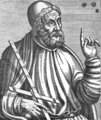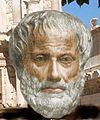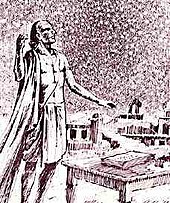History of mathematics
The history of mathematics goes back to antiquity and the beginnings of counting in the Neolithic Age. Evidence of the first beginnings of counting methods goes back about 50,000 years. The building of pyramids in Ancient Egypt over 4500 years ago, with its precisely calculated shapes, is a clear indication of the existence of already extensive mathematical knowledge. In contrast to the mathematics of the Egyptians, of which only a few sources exist because of the fragile papyri, there are about 400 clay tablets of Babylonian mathematics in Mesopotamia. The two cultural areas had different number systems, but both knew the four basic arithmetic operations as well as approximations for the circular number π 
Mathematics in Greece
The mathematics of ancient Greece divides into four major periods:
- Ionian period (Ionian philosophy/Presocratics: Thales, Pythagoras, Anaxagoras, Democritus, Hippocrates, Theodoros) from 600 to 400 BC.
- Athenian period (Sophists, Plato, Aristotle, Theaitetus, Eudoxus of Knidos, Menaichmos, Deinostratus, Autolykos of Pitane) from 400 to 300 BC.
- Alexandrian period (Euclides, Aristarchus, Archimedes, Eratosthenes, Nicomedes, Apollonios) from 300 to 200 BC.
- Late period (Hipparchus, Menelaus, Heron of Alexandria, Ptolemy, Diophant of Alexandria, Pappos) from 200 BC to 300 AD.
· 
Thales
· 
Archimedes
· 
Heron of Alexandria
· 
Claudius Ptolemy
According to a tradition dating back to antiquity, but disputed among historians of science, the history of mathematics as a science begins with Pythagoras of Samos. The principle that "everything is number" is attributed to him - though probably wrongly. He founded the school of the Pythagoreans, from which mathematicians such as Hippasos of Metapont and Archytas of Tarentum later emerged. Unlike the Babylonians and Egyptians, the Greeks had a philosophical interest in mathematics. Among the findings of the Pythagoreans was the irrationality of geometrical distance ratios, which is said to have been discovered by Hippasos. However, the formerly widespread view that the discovery of irrationality caused a philosophical "crisis of fundamentals" among the Pythagoreans, since it shook their earlier beliefs, is rejected by contemporary scholars. The ancient legend that Hippasos committed treason by publishing his discovery is said to have arisen from a misunderstanding.
In the Platonic Academy in Athens, mathematics was highly valued. Plato held it in high esteem, as it served to be able to attain true knowledge. Greek mathematics then developed into a proving science. Aristotle formulated the foundations of propositional logic. Eudoxos of Knidos created for the first time a rudimentary form of infinitesimal calculus with the exhaustion method. However, because of the lack of real numbers and limits, this method was quite unwieldy. Archimedes extended it and used it to calculate, among other things, an approximation for the circular number π.
· 
Plato
· 
Aristotle
· 
Euclid of Alexandria
· 
Democritus
Euclid summarized in his textbook Elements a large part of the then known mathematics (geometry and number theory). Among other things, it proves that there are an infinite number of prime numbers. This work is considered a prime example of mathematical proof: all results are derived from a few specifications with a rigor that is said to have never existed before. Euclid's "Elements" is still used as a textbook today after more than 2000 years.
In contrast to the Greeks, the ancient Romans were hardly concerned with higher mathematics; they were more interested in practical applications, for example in surveying and engineering. The Roman surveyors were called gromatici or agrimensors; their writings were collected in a compilation (Corpus Agrimensorum) in the 6th century. Important agrimensors were Sextus Iulius Frontinus, Hyginus Gromaticus, and Marcus Iunius Nipsus. Until late antiquity, mathematics remained largely the domain of the Greek-speaking inhabitants of the empire, and the focus of mathematical research in Roman times was on Sicily and in North Africa, there especially in Alexandria. Pappos made new contributions to geometry (including the first results on projective geometry), Apollonios to conic sections, and Diophant made contributions to a geometrically disguised algebra and to number theory (solving integer equations, later called Diophantine problems after him). The last mathematician known by name in Alexandria was Hypatia, who was killed by a Christian mob in 415.
Chinese and Indian mathematics
China
→ Main article: Mathematics in ancient China
The first surviving textbook of Chinese mathematics is the Zhoubi suanjing. It was completed during the Han Dynasty, between 206 BC to 220 AD, by Liu Hui, since as a result of the book and document burnings during the Qin Dynasty most mathematical records had been destroyed and were rewritten from memory. The mathematical findings are dated to the 18th century BC. It was followed later by more additions until 1270 AD. It also contains a dialogue about the calendar between Zhou Gong Dan, the Duke of Zhou, and the minister Shang Gao. Almost as old is Jiu Zhang Suanshu ("Nine Chapters on Mathematical Art"), which contains 246 problems on various subjects; among other things, it includes the Pythagorean theorem, but without any proof. The Chinese used a decimal place value system of horizontal and vertical strokes (called Suan Zi, "calculating with stakes"); around 300 AD Liu Hui calculated the number 3.14159 over a 3072-square as an approximation for π.
Chinese mathematics reached its peak in the 13th century. The most important mathematician of this time was Zhu Shijie with his textbook Siyuan Yujian ("precious mirror of the four elements"), which dealt with algebraic systems of equations and algebraic equations of the fourteenth degree and solved them by a kind of Horner method. After this period, mathematics in China came to an abrupt halt. Around 1600, Japanese took up the knowledge in Wasan (Japanese mathematics). Their most important mathematician was Seki Takakazu (around 1700). Mathematics was practiced as a secret temple science.
India
Dating, according to a bon mot by the Indologist W. D. Whitney, is extremely problematic throughout Indian history.
The oldest hints about geometrical rules for the construction of sacrificial altars are already found in the Rig Veda. But only several centuries later the Sulbasutras ("rope rules", geometrical methods for the construction of sacrificial altars) and other doctrinal texts such as the Silpa Sastras (rules for temple construction) etc. came into being (i.e. were canonized). Possibly semi-reliably dated to about 500 AD are the Aryabhatiya and various other "Siddhantas" ("systems", mainly astronomical tasks). The Indians developed the decimal positional system with which we are familiar, i.e. the polynomial notation to base 10 as well as the corresponding rules of calculation. Written multiplication in Babylonian, Egyptian or Roman number notation was extraordinarily complicated and worked by means of substitution; i.e. with many decomposition and summary rules related to the notation, while in Indian texts many "elegant" and simple procedures can be found, for example, already for written root extraction.
Our numeral signs (Indian numerals) for the decimal digits are derived directly from the Indian Devanagari. The earliest use of the numeral 0 is dated to about 400 A.D.; Aryabhata around 500 and Bhaskara around 600 used it in any case already without shyness, his contemporary Brahmagupta even reckoned with it as a number and knew negative numbers. The naming of the numerals in different cultures is inconsistent: the Arabs call these (adopted Devanagari) numerals "Indian numerals", the Europeans, on the basis of medieval reception history, "Arabic numerals", and the Japanese, for an analogous reason, Romaji, that is, Latin or Roman numerals (together with the Latin alphabet). By "Roman numerals" Europeans, in turn, understand something else.
With the spread of Islam to the East, around 1000 to 1200 at the latest, the Muslim world adopted many of the Indian findings; Islamic scholars translated Indian works into Arabic, which also reached Europe via this route. A book by the Persian mathematician Muhammad ibn Musa Chwarizmi was translated into Latin in Spain in the 12th century. Indian numerals (figurae Indorum) were first used by Italian merchants. Around 1500, they were known in the territory of what is now Germany.
Another eminent mathematician was the astronomer Bhaskara II (1114-1185).

Aryabhata
Search within the encyclopedia